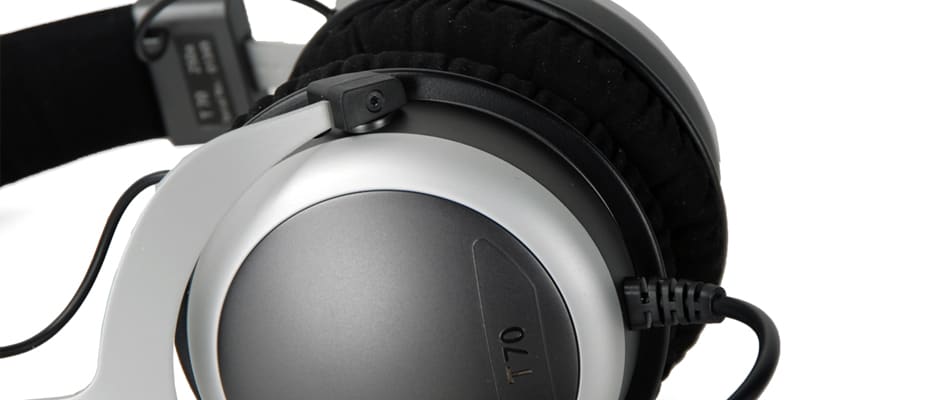Introduction
Product Overview
{{section_header}}{{section.name}}{{/section_header}}
Meet the Beyerdynamic T 70 Over-ear headphones.
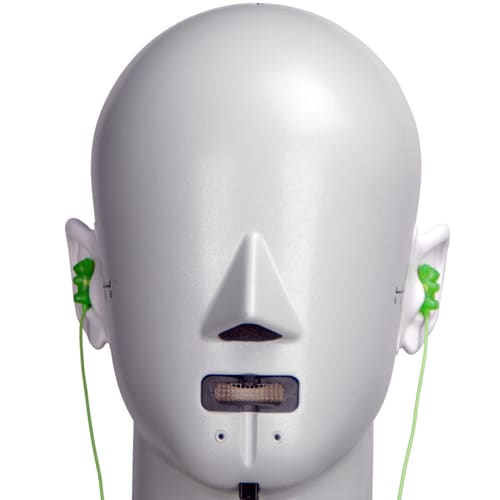
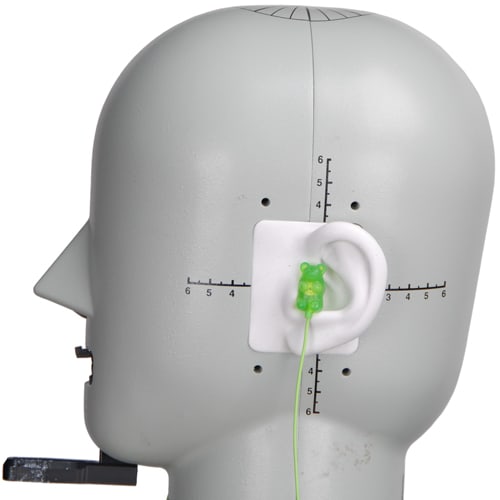
Speakers
{{section_header}}{{section.name}}{{/section_header}}
Here we see the foam padding guarding the speaker element. The ear cups pop off for easy cleaning, revealing what you see here.
Back
{{section_header}}{{section.name}}{{/section_header}}
The closed backs of the {{product.name}} guard the powerful drivers ensconced within. They may not be flashy, but they certainly are not too difficult to look at. Beyerdynamic is known for its no-nonsense designs in its high-end headphones, and the {{product.name}}s are no different.
Band
{{section_header}}{{section.name}}{{/section_header}}
Here we observe the padded leather band of the {{product.name}}, which gently cradles your cranium, and keeps your cans fit snugly to your ear.
Cable
{{section_header}}{{section.name}}{{/section_header}}
The typically cumbersome cable of high-end headphones makes another appearance here, as the cable of the {{product.name}} is 9.8 feet long. Considering the fact that this cord is very difficult to stow and manage without employing the spiral rubber piece that comes with these cans, you probably will want to keep these in one spot.
The plug of the {{product.name}}s at first glance is a regular ol' straight 1/4th inch connection, but wait! There's more! If you find yourself wanting a 1.8th inch plug, simply unscrew the gold-plated 1/4th inch plug, and you will discover that the outer plug was really just an adapter.
The cord guards of the {{product.name}} are fairly thick rubber, which will keep your cables from destroying their internal solder points fairly well. Still, we advise you not to try to test this out on your own.
In the Box
{{section_header}}{{section.name}}{{/section_header}}
When you open the package of the {{product.name}}s with the feverish enthusiasm of a young child at their birthday party, you'll find your headphones, a huge carrying case, a rubber spiral to manage your cable, and assorted documentation inside.
Durability
{{section_header}}{{section.name}}{{/section_header}}
Though many high-end cans will have features that can greatly extend the life of your headphones, like removable cables or reinforced cables, the {{product.name}}s don't have these features. That's not to say that these things can't take a beating; they can. It's just a matter of knowing where they're likely to break. There are no cheap materials here, and you are unlikely to have significant issues, but be wary of the long cable, because it cannot be replaced easily.
Aesthetics
{{section_header}}{{section.name}}{{/section_header}}
Though Beyerdynamic is not known for making the flashiest cans on the market, they do make an attractive product. Though they're a bit understated, the {{product.name}}s have a clean look about them that will not be offensive to the eyes.
Frequency Response
{{section_header}}{{section.name}}{{/section_header}}
Beyerdynamic rolled out their line of Tesla headphones earlier in the year, and this is the first pair that we've been able to review fully. While the technology Beyerdynamic released for this line of headphones is new and exciting, it seems to have a little ways to go. From what we've seen, these headphones perform very well, but not at their price point.
For example, take a look at the frequency response graph below: notice that although for the most part, the {{product.name}}s perform very closely to what we've seen from other Beyerdynamic models in the past, there is a rather bizarre area of underemphasis from 5.5 to 8kHz, making high mids and treble sounds very muffled, and very distracting. We're not sure why this is the case, but it's a flaw that these cans were not able to correct even after scores of hours of burn-in and many tests.
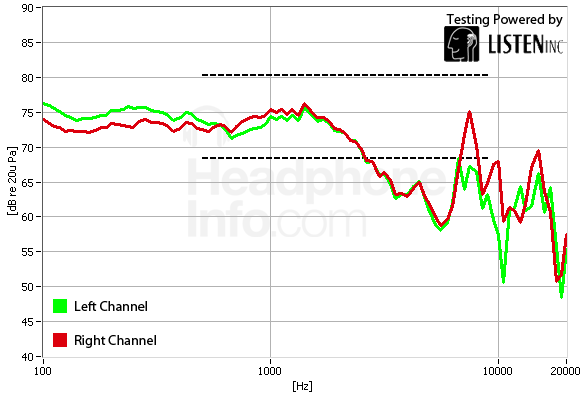
Click here for more information on our frequency response test.
Distortion
{{section_header}}{{section.name}}{{/section_header}}
The {{product.name}}s have very little in the way of distortion, and certainly not enough for you to notice. Some audiophiles will be quick to point out that it's still there, but honestly, unless you're going to crank these cans as far as they can go without blowing them out, you won't hear any distortion.
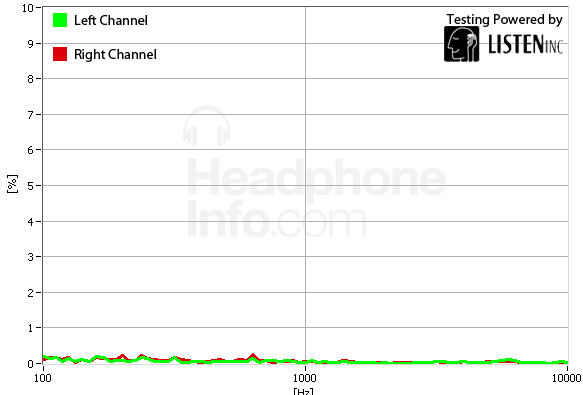
Click here for more information on our frequency response test.
Tracking
{{section_header}}{{section.name}}{{/section_header}}
Aside from a bizarre shift in channel preference at about 5.5kHz, these cans have a somewhat even tracking response, though there are several 1-2dB shifts between channel preferences. These shifts are very quiet, and are very unlikely to be heard.
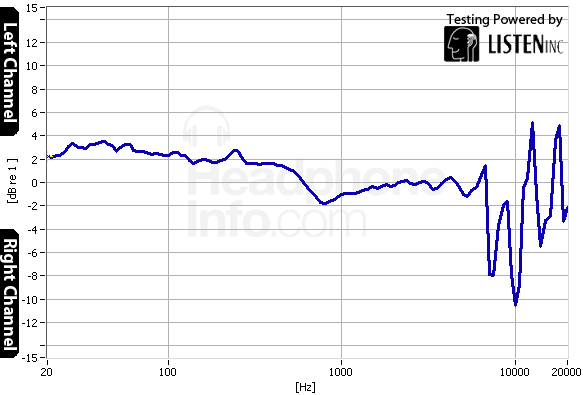
Click here for more information on our frequency response test.
Isolation
{{section_header}}{{section.name}}{{/section_header}}
When listening to music, isn't it a pain to have to raise your volume level due to outside noise? Well, if you're listening in the right environment, the {{product.name}}s will help you prevent this, as they block out quite a bit of mid to high-range noise. Though it's true that you'll be very likely to hear any low-end noise that's near you, these cans are as good or better than your standard foam earplugs at noise attenuation in the mid to high-end.
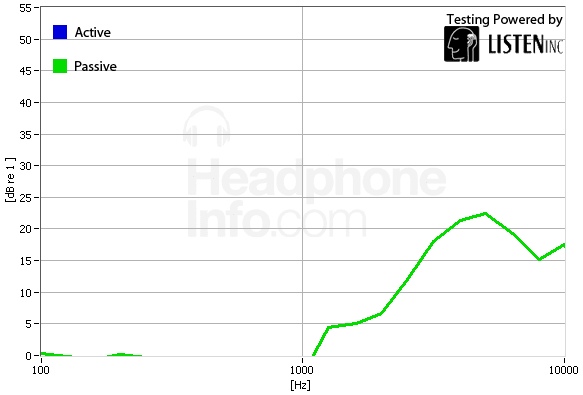
Click here for more information on our isolation test.
Leakage
{{section_header}}{{section.name}}{{/section_header}}
Not all headphones are made perfect, and the {{product.name}}s are no different. Though they are closed-backed cans, they do leak a fair bit of sound to the outside world. We suggest keeping these particular cans in the privacy of your own home if you absolutely must rock out to something embarrassing.
Click here for more information on our leakage test.
Maximum Usable Volume
{{section_header}}{{section.name}}{{/section_header}}
While it's a very foolish thing to be listening to these or any other headphones at this level, the {{product.name}}s can output sound at 112-plus decibels when it reaches the magic 3% distortion mark. While this means that you can listen to music at a high volume without worrying about distorted sound, we implore you to reconsider this activity, as even a level of 90dB can be dangerous. To learn more about acceptable listening volumes, please read our segment on Noise-Induced Hearing Loss.
Click here for more on our maximum usable volume test
Short-Term Use
{{section_header}}{{section.name}}{{/section_header}}
When first putting on the {{product.name}}s, you'll notice how well they cradle your skull, and how well they evenly distribute their weight on the side of your head. They seem to do a good job of accommodating other head sizes as well, so you shouldn't expect there to be much pinching or general discomfort.

Extended Use
{{section_header}}{{section.name}}{{/section_header}}
After listening to the {{product.name}}s for a period of six hours or more, there were a couple complaints about heat buildup in the office, but only a few people had this trouble. On the whole, the {{product.name}}s hold up very well over time, and don't slide around too much.
Customizability
{{section_header}}{{section.name}}{{/section_header}}
Unless you purchase your headphones from the MANUFAKTUR section of the Beyerdynamic website, there really isn't a whole lot you can do to customize your {{product.name}}s outside of perhaps ordering new ear pads in the future. These are pretty much come-as-they-are headphones.
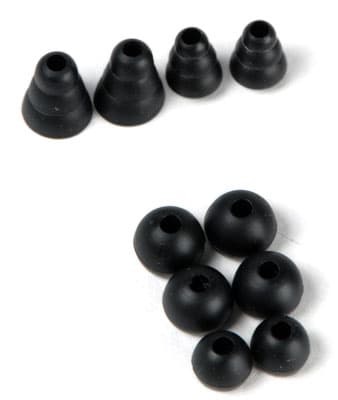
Cable Connectivity
{{section_header}}{{section.name}}{{/section_header}}
As previously discussed, the {{product.name}}s have a straight, 1/8th-inch plug that can be used as a 1/4th-inch plug with the included adapter that screws onto the base of the plug. There aren't any in-line accessories that come with the {{product.model}}s, so this is as far as we go in this category.
Portability
{{section_header}}{{section.name}}{{/section_header}}
Though it is true that these headphones come with a carrying case, don't take that to mean that these cans are in any way a portable music listening option. Quite the opposite is true, in fact. Though it is possible for these things to venture away from the computer without getting broken, these are not cans you're going to be listening to with your mobile media platform. Especially when you consider that they have a 9.6-foot long cord.
Maintenance
{{section_header}}{{section.name}}{{/section_header}}
Outside of being able to pull off the ear pads to clean the foam guarding the speaker element, there really is not a whole lot you can do to maintain these headphones. Should the cord break, the {{product.name}}s do not have detachable cable structures, so unless you're very used to soldering electronics, you may be out of luck.
Design
{{section_header}}{{section.name}}{{/section_header}}
Though open-backed headphones are slightly different in design to their closed-back cousins, they are often prized by audiophiles for their open soundstage. Though for some people they may prefer this type of headphone, they come with tradeoffs like durability and portability. If you ever want to listen to your hi-fi set away from the computer, we strongly suggest you stay away from getting an open-backed set. If you are a bigger fan of an open soundstage and don't plan on keeping your cans in a place where they are likely to get damaged, you may want to give the DT 990 PROs a look.
Frequency Response
{{section_header}}{{section.name}}{{/section_header}}
You will probably notice right away that the frequency response of the {{product.name}}s and that of the DT 990 PROs are very similar outside of the major blemish in the 5.5-8kHz range. The Beyerdynamic Tesla driver technology is still new, so we expect this will probably get better with later models, but for now, we'd stick with the DT 990 PROs.
Distortion
{{section_header}}{{section.name}}{{/section_header}}
Though neither really have an issue here, the DT 990 PROs have less distortion.
Tracking
{{section_header}}{{section.name}}{{/section_header}}
Again, the DT 990 PROs have the better response here, even though the {{product.name}}s aren't really all that bad to begin with.
Isolation
{{section_header}}{{section.name}}{{/section_header}}
Due to the very nature of closed versus open backed headphones, the closed backs will almost always attenuate more noise, as do the {{product.name}}s in contrast to the DT 990 PROs.
Comfort
{{section_header}}{{section.name}}{{/section_header}}
Though both pairs of headphones are comfortable, the DT 990 PROs have a tendency to dig into your scalp a little bit at the band, so we'll give this one to the {{product.name}}s. Still, different people have different heads, so try each on before you buy if you are able.
Verdict
{{section_header}}{{section.name}}{{/section_header}}
Though it's clear that Beyerdynamic continues to do a fantastic job at making headphones, there are some obvious hurdles that its new line of Tesla headphones need to overcome before they can be considered some of the best on the market, especially at their price point. With really bizarre deficiencies in their frequency response, chances are good that any discerning audiophile will gravitate more towards that of the DT 990 PROs rather than the T 70s. Still, if you demand durability from your cans, the T 70s merit a second look.
Design
{{section_header}}{{section.name}}{{/section_header}}
Very popular in the DJ community, the Audio Technica ATH-M50s are well-regarded closed back over-ears that while durable, are also very sleek looking. Much more affordable than the {{product.name}}s, they can go outside if need be. Though the {{product.name}}s are much more smooth-looking and polished, if you're looking for durability, the ATH-M50s are a better bet overall.
Frequency Response
{{section_header}}{{section.name}}{{/section_header}}
This is something we did not expect, but it's worthy discussing: both frerquency responses are fairly similar in many regards. Though the drop at 6kHz isn't as pronounced in the ATH-M50s as it is in the {{product.name}}s, it's still there. Both headphones ease back on the emphasis of the 5-8kHz range, and stay somewhat flat up until that range. Both boost the highest end a bit, but the {{product.name}}s are a little more pronounced. This comparison is a bit of a wash.
Distortion
{{section_header}}{{section.name}}{{/section_header}}
Though both sets of cans have very little distortion at all, the ATH-M50s technically have less.
Tracking
{{section_header}}{{section.name}}{{/section_header}}
Despite the fact that both sets of headphones have their tracking issues, the ATH-M50s have somewhat more pronounced shifts all along the frequency spectrum tested. Though it's not extremely pronounced, it's slightly audible.
Isolation
{{section_header}}{{section.name}}{{/section_header}}
Here's where we start to see a bit of separation between the {{product.name}}s and the ATH-M50s. While neither are great at making the world around you disappear, the {{product.name}}s attenuate much more of the mid-range frequencies, even if neither attenuate the low end much at all.
Comfort
{{section_header}}{{section.name}}{{/section_header}}
This comparison is very subjective, but in our labs, the {{product.name}}s were slightly better-received than the ATH-M50s, as they distribute their weight better, and don't tend to pinch the very ends of larger pinnae. Try these on before you buy, as heads are very different in size and shape, your experience will not necessarily mirror ours.
Verdict
{{section_header}}{{section.name}}{{/section_header}}
If you're worried about price, the ATH-M50s offer better bang for your buck, and somewhat comparable performance. While the T 70s do have a couple eccentricities, they do not really set themselves apart from other closed back headphones to justify their price point, even if they technically perform better in some areas. We'd stick with the Audio Technicas here.
Design
{{section_header}}{{section.name}}{{/section_header}}
We don't need to point out that in-ears are very different by design to over-ear headphones, but we always like to compare headphones of other types to discuss their advantages that some consumers might not be aware of. For example, did you know that you can replace the cables of the Shure SE535s if they break? Or that they offer superior isolation by design? Probably not, but it's worth discussing.
Frequency Response
{{section_header}}{{section.name}}{{/section_header}}
While both sets of headphones have their issues with frequency response, we actually prefer that of the {{product.name}}s, as they preserve much more of the higher-end than do the Shures. For whatever reason, the SE 535s stray below our ideal limits for a wide range of frequencies, and seem to get worse the higher they go. The frequency response of the {{product.name}}s may not be ideal, but it's better than that of the Shures.
Distortion
{{section_header}}{{section.name}}{{/section_header}}
Neither of these headphones have much distortion to speak of, but the {{product.name}}s technically have a much lower SPL of distortion.
Tracking
{{section_header}}{{section.name}}{{/section_header}}
While the tracking of the Shures may be off a little bit towards preferring the right channel, it's almost perfectly flat, meaning that you will not hear this channel preference in all likelihood. This is a better response than what the {{product.name}}s gave us, which is a bit erratic.
Isolation
{{section_header}}{{section.name}}{{/section_header}}
Here is where in-ears typically set themselves apart from all other types of headphones: isolation. The Shure SE535s block out a ton more noise than do the {{product.name}}s. Because they sit in the ear canal, the Shures directly block out the sound, preventing much of anything from even reaching the eardrum. Notice that the {{product.name}}s can't even touch the isolation offered by the in-ears.
Comfort
{{section_header}}{{section.name}}{{/section_header}}
Perhaps the biggest tradeoff that comes with in-ears is comfort. Though some are more comfortable than others, you're still essentially jamming bits of plastic and rubber into orifices that aren't meant to have anything in them to begin with. On the other hand, the {{product.name}}s gently rest outside your ears without putting a lot of pressure on any one area of your head. Though comfort is very subjective, we'd stick with the {{product.name}}s on this one.
Verdict
{{section_header}}{{section.name}}{{/section_header}}
Each pair of headphones are more suited for different uses: if you want to take your cans outside to jog or need your headphones to survive everything you can throw at them, the Shure SE535s are probably your best bet. If you're looking for audio quality and comfort above all else, stick with the {{product.name}}s.
Design
{{section_header}}{{section.name}}{{/section_header}}
Though both headphones are over-ear cans, the Monster Beats Pro are more geared towards getting you noticed than they are built for audio quality, but they do offer a certain level of durability that isn't often seen in the mass-consumer market. If you don't need to feel like a superstar in your own home, the {{product.name}}s are very pragmatic-looking, and will stand up to the rigors of living no a desk.
Frequency Response
{{section_header}}{{section.name}}{{/section_header}}
As unexpected a result as this is, the Beats Pros managed to stay within our ideal limits much better than the {{product.name}}s did, due almost entirely to the strange dip at the 5.5-8kHz mark. While on the whole the {{product.name}}s have the flatter response without crazy amounts of bass, the Beats Pros do net the higher score here, regardless of overemphasized bass levels.
Distortion
{{section_header}}{{section.name}}{{/section_header}}
Neither set of headphones had much of anything in the way of distortion.
Tracking
{{section_header}}{{section.name}}{{/section_header}}
Both headphones are a little erratic in their tracking, but nothing that you'll probably hear in any capacity. Most, if not all the shifts in channel preference are less than 4dB to one side or another.
Isolation
{{section_header}}{{section.name}}{{/section_header}}
The {{product.name}}s block out a bunch more ambient noise than the Monster Beats do, offering as much as 10dB more attenuation than the Beats Pros in some ranges.
Comfort
{{section_header}}{{section.name}}{{/section_header}}
This comparison will probably vary from person to person, but in the lab, we found that the Beats Pros tended to grip our skulls a bit too tightly for our comfort. The {{product.name}}s, on the other hand, cradle the cranium much more efficiently and gently, allowing for more comfortable prolonged listening sessions.
Verdict
{{section_header}}{{section.name}}{{/section_header}}
As most of our verdicts go, this one is not much different: which headphone is more desirable depends entirely upon what you want from it. If you want to hit the town with flashy cans and extremely durable hardware, we recommend grabbing the Beats Pros. If you'd rather stay at home with a pair of cans that won't become uncomfortable over a long period of time, and have mostly impressive audio quality, we'd suggest sticking with the {{product.name}}s.
Conclusion
{{section_header}}{{section.name}}{{/section_header}}
Earlier this year, Beyedynamic announced their line of Tesla headphones, which promised a new improvement on the dynamic driver design. By drastically increasing the magnetic strength of the drivers, Beyerdynamic has created drivers that require fewer voice coils to operate, and theoretically creating a driver that can move quicker, making the sound more accurate. While it's certainly possible that this is the case, we currently do not test for clarity, thus we cannot tell you for certain with scientifically-collected data.
While the {{product.name}} is certainly impressive in many respects, we find that it does have some troubles that Beyerdynamic headphones typically do not have. We realize that it may take a while for Beyerdynamic's new technology to mature and become as polished as some of its older models of premium headphones, but it's not quite there yet.
All that being said, if you're an audiophile looking for something new that works very hard to preserve detail in sound, the {{product.name}}s, and the rest of the Tesla line are certainly worth a listen. Like we said, there are some blemishes in performance that are a little mystifying, but nothing that should destroy your listening experience, especially if you are a fan of high levels of detail in your music. Just be ready to pay through the nose for the novelty of having a driver that generates a magnetic field of 1.2 Tesla.
Meet the tester
A seasoned writer and professional photographer, Chris reviews cameras, headphones, smartphones, laptops, and lenses. Educated in Political Science and Linguistics, Chris can often be found building a robot army, snowboarding, or getting ink.
Checking our work.
Our team is here to help you buy the best stuff and love what you own. Our writers, editors, and experts obsess over the products we cover to make sure you're confident and satisfied. Have a different opinion about something we recommend? Email us and we'll compare notes.
Shoot us an email